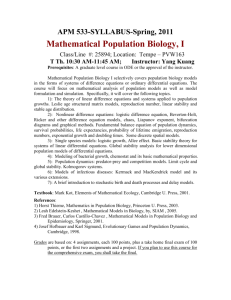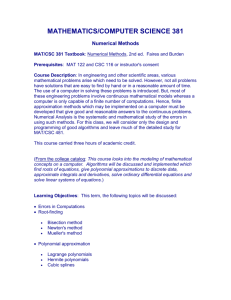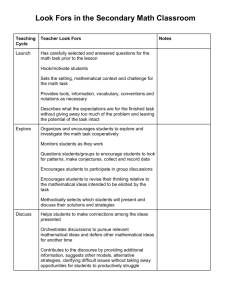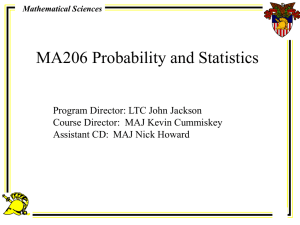Research Review essay
advertisement
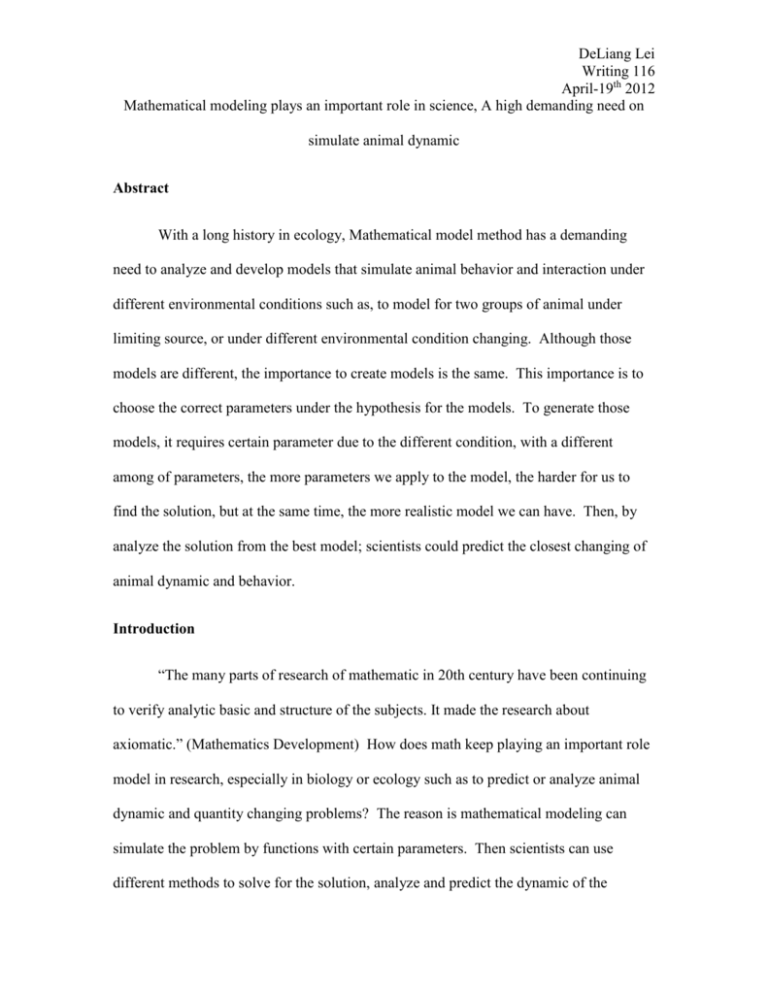
DeLiang Lei Writing 116 April-19th 2012 Mathematical modeling plays an important role in science, A high demanding need on simulate animal dynamic Abstract With a long history in ecology, Mathematical model method has a demanding need to analyze and develop models that simulate animal behavior and interaction under different environmental conditions such as, to model for two groups of animal under limiting source, or under different environmental condition changing. Although those models are different, the importance to create models is the same. This importance is to choose the correct parameters under the hypothesis for the models. To generate those models, it requires certain parameter due to the different condition, with a different among of parameters, the more parameters we apply to the model, the harder for us to find the solution, but at the same time, the more realistic model we can have. Then, by analyze the solution from the best model; scientists could predict the closest changing of animal dynamic and behavior. Introduction “The many parts of research of mathematic in 20th century have been continuing to verify analytic basic and structure of the subjects. It made the research about axiomatic.” (Mathematics Development) How does math keep playing an important role model in research, especially in biology or ecology such as to predict or analyze animal dynamic and quantity changing problems? The reason is mathematical modeling can simulate the problem by functions with certain parameters. Then scientists can use different methods to solve for the solution, analyze and predict the dynamic of the DeLiang Lei Writing 116 April-19th 2012 animals. This is important to science, because science needs to prove their hypothesis with scientific experiments, but no experiment is perfect! Therefore, we can apply mathematical analysis to make the experiment become more accurate because math has enormous amount of insight. The way to apply mathematical analysis for the problems is to build up mathematical models. Those models can simulate the interaction of the problem by collect data difference, mapping, transform, simulate interaction, etc. Therefore, by analyzing the solution from the equations of the model, scientists can make the prediction and analyze the happening under their assumption and hypothesis. Background Mathematical models have a long history in ecology (Upadhyay et al 2011), there have been a demanding need for developing and analyzing models of interacting species in ecosystem (El-Sheikh et al 2011) such as by simulating the interaction between large groups of animal behavior (Lett et al 2008). Scientists can predict the future changes of the animals. For example, they could predict the motion of fish school, bird flocks, insect swarms, mammal herds, (Lett et al 2008) even the huddle movement of a large group of penguins. They could also, predict the quantity interaction of a predator-prey system under some perfect condition assumptions, or the dynamic involve three different types of animal, or animal food chain behavior in both normal and harsh environments. It seems hard to imagine that mathematic equations could simulate the dynamic between animals. Although some models, like ordinary differential equations (ODE), were not rigorously tied to field data because motivational variables are not measurable, and because many action patterns are variable rather than fixed (Henson et al 2007), we could still create a better mathematic model with large parameters to represent each condition DeLiang Lei Writing 116 April-19th 2012 apply to the problem that we need, like Shandelle Henson mention in his paper “Accurate prediction of behavior dynamics require the construction of mathematical model that operate on scales (parameters) at which deterministic trends emerge from variability among individuals,” (Henson et al 2007) which imply the importance of parameters in mathematical modeling, the more parameters we apply to the model, the more realistic model we could generate. Method: Mathematical models need to generalize then describe and analyze for the animal dynamic problems. Each type of animal dynamic problems has their fundamental type of equations system and method. Different conditions lead to different environment, position, temperature, growth rate or dead rate, etc, which these mean we need to use the correct parameters. With more parameters to represent the differences, we can simulate a more accurate model to predict the changing of animal behaviors. First, before building up the model, scientists need to know, under their hypothesis and question, which type of equation system is the fittest model for them to develop in order to reach their goal. Then, they can write down the equation system and modify it with necessary parameters which those parameters can describe the certain conditions under their hypothesis. Since no mathematic model can fully describe the whole picture of any real case of animal dynamic with limited parameters, they just simulate the most optimal case under scientists’ hypothesis. So, those equations systems can be very fundamental like system 1, and system 2, the simplest predator-prey system equation. Or they can be very precise with many parameters like David Szekely and his DeLiang Lei Writing 116 April-19th 2012 colleagues generalize a model with up to 22 parameters to record a cardiac ion channel (Szekely et al 2011). System1 or System 2 (El-Sheikh et al 2011) dx/dt=(a(1)-b(1)*y)*x dx/dt=x*g(x)-y*p(x)-q(1)*E(1)*x (El-Sheikh et al 2011) dy/dt=(-a(2)+b(2)*x)*y dy/dt=-D*y+s*y*p(x)-q(2)*E(2)*y (El-Sheikh et al 2011) System 1 and system 2 are fundamental because they only have a few parameters under some hypothesis with an optimal conditions idea, like in system 1, the four parameters, a(1), b(1), a(2), b(2) represent the logistic growth rate and death rate of two groups of animal. And there are only two groups of animal in this ecosystem which they are the predator (x) and the prey (y). And the population changing between the two groups is only affect by themselves, which denote by the parameters, a(1), b(1), a(2), b(2). So, we have two equations, dx/dt=(a(1)-b(1)*y)*x which represent the population change rate of the predator (x); and dy/dt=(-a(2)+b(2)*x)*y which represent the population change rate of the prey (y). In, system 2, it has six parameters, E(1), E(2), D, s, q(1), and q(2) (El-Sheikh et al 2011). They also represent specific conditions which the E’s denote the harvesting efforts for the predator and prey; s and D represent the conversion efficiency rate of the prey to predator, and predator death rate (El-Sheikh et al 2011). Similarly, these two equations in system 2 represent the same population change rate of predator and prey, but with different hypothesis, they have different numbers of parameters, and different accuracy to the condition. DeLiang Lei Writing 116 April-19th 2012 In another hand, the equations systems can be very complicate with a bunch of parameters, such as in Upadhyay’s article, Challenges of living in the harsh environments, a mathematical modeling study, there are 12 parameters in the first system to describe the problem (Upadhyay et al 2011). Moreover, David Szekely uses up to 22 parameters to demonstrate the power and efficiency of an electrophysiological model (Szekely et al 2011) in order to make it approach to the solution efficiently and accurately. However, the more parameters we apply to system, the harder to solve for the problem, like Szekely and his colleagues need to modify a version of the curvilinear gradient method, use a computational program mathematica and develop a 13-step method to reach their solution (Szekely et al 2011). But in the same time, the solution is closer to the real case. Second, we can solve for the problem with mathematical methods. Those methods could be: finding the critical point by maximize or minimize the equations; prove the theorem and develop the equation in order to find the equilibrium points; or if necessary, we have to use special methods like the curvilinear gradient method (Szekely et al 2011), or we have to develop our develop a new version of method from our cumulative math skills to find the optimal solution in order to analyze the quantity cycle and base dynamic between the two groups of animal. For example, in system 2, easily, the authors use theorems of the equations and the Jacobian matrix to find all the equilibrium points from the system. Like first, they set up the relationship between the two equations from system 2. Second, apply an inequality theory to the relationship equation, and then use the limit to approximate the solution into the region where the equilibrium point lives in. At last, they come out the equilibria of the system 2 are the intersection points DeLiang Lei Writing 116 April-19th 2012 isoclines at dx/ds=0 and dy/ds=0, which obviously shows that, it has a trivial equilibrium point P(0) at (0,0). So, they try to find the nature equilibria with the Jacobian matrix from the system to find the equilibrium point of system 2. (ElSheikh et al 2011) But on another hand, when we simulate the model with a lot of parameters, some questions are going to cumber our progress, like Szekely and his colleague not only have to apply curvilinear gradient method to their problem, but also have to developed an optimization routine base on a combination of genetic algorithm and modify the version of curvilinear gradient method to go over the challenges of the large group of parameters (Szekely et al 2011). Also, in order to find their solution, they develop a 13 steps procedure to reach their goal, figure 1 shows this procedure of their 13-step method. (Szekely et al 2011). Figure 1, Overview of the modified curvilinear gradient method. Rectangles indicate a process or term/s to be evaluated; diamonds indicate a test where true and false returns are indicated by green and red, respectively. (Color figure online) (Szekely et al 2011). DeLiang Lei Writing 116 April-19th 2012 At last, we could analyze the solution mathematically or numerically, which mathematically means to use simple graphs, comparing numbers, location of minimum or maximum points, intersection, etc, to analyze the changing under time processes; and numerically means to use computer mathematic software such as matlab, maple, mathematica, to simulate the motion or long term behavior into time period graphs, with those computational programs, we can easily graph the long term behavior graphs to see its dynamic cycle of the animals like the figures from El-Sheikh’s article, figure 2, figure 3, figure 4, and figure 5 (Szekely et al 2011). Figure 2 (El-Sheikh et al 2011) Figure 3 (El-Sheikh et al 2011) Figure4 (El-Sheikh et al 2011) Figure 4 (El-Sheikh et al 2011) DeLiang Lei Writing 116 April-19th 2012 They all represent there exists at least on limit cycle under different condition points, and also tell us the quantity changing of two groups of animal over time which the x-axis represent one type of animal, and the y-axis represent the other type of animal. (ElSheikh et al 2011) Then, with the graphs, we can predict the dynamic of the problems (Lett et al 2008). We know there is no perfect model could help us to predict the exact dynamic in reality, and sometime, our hypothesis may fail into the wrong direction. So, we could always try to use other parameters and methods to create and solve for a new mathematical model. Then, analyze the new model data, graphs; and compare them with the old model. By estimating the parameters, checking the model validation, we can choose the best model that fits the hypothesis and assumption. Conclusion: As a fundamental knowledge, math always plays the mainstay role to support other intelligent aspects. Mathematical modeling is a primary example in representing math as an important tool for scientists to improve experimental accuracy. Although there is no model can be perfect, with more parameters, mathematical modeling can provide a better solution for scientists to analyze and predict the future happenings under reasonable assumption and hypothesis. In biology and ecology aspect, mathematical modeling simulates the animal dynamic, helps the scientists to model the motion large group of animals and to develop the behavior of animal food chain under different environment condition. With the data from those models, it might benefit us to investigate the evolution in different species and their behavior in the future, and it may induce a way for us to communicate with other species on Earth. DeLiang Lei Writing 116 April-19th 2012 References El-Sheikh, M., El-Marouf, S. A., & Alaofy, Z. M. (2011). On the Dynamics of a General Predator-Prey System. Journal Of Mathematics & Statistics, 7(4), 295-301. Henson, S. M., Dennis, B., Hayward, J. L., Cushing, J. M., & Galusha, J. G. (2007). Predicting the dynamics of animal behaviour in field populations. Animal Behaviour, 74(1), 103-110. doi:10.1016/j.anbehav.2006.11.015 In Mathematics Development, from http://library.thinkquest.org/22584/# Lett, C., & Mirabet, V. (2008). Modelling the dynamics of animal groups in motion . South African Journal Of Science, 104(5/6), 192-198. Szekely, D., Vandenberg, J. I., Hill, A. P., & Dokos, S. (March 01, 2011). An improved curvilinear gradient method for parameter optimization in complex biological models. Medical and Biological Engineering and Computing, 49, 3, 289-296 Upadhyay, R. K., Rai, V. V., & Raw, S. N. (2011). Challenges of living in the harsh environments: A mathematical modeling study. Applied Mathematics & Computation, 217(24), 10105-10117. doi:10.1016/j.amc.2011.05.006

